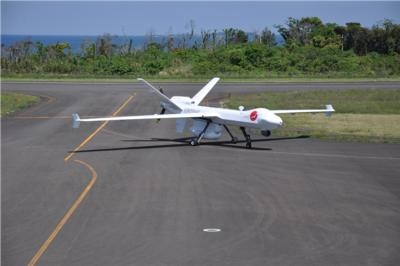Wed, Jun 27, 2018
Has Been Operated By U.S. CBP Since 2008
General Atomics Aeronautical Systems (GA-ASI) has concluded the first large-scale demonstration flights in Japan of the Guardian Remotely Piloted Aircraft (RPA).

"We thank the Mayor of Iki and the many other public and private stakeholders who made this demonstration possible,” said Linden Blue, CEO, GA-ASI. “We believe that the flights of long-endurance RPAs in Japan’s maritime environment yielded valuable information, and we now begin the process of reviewing the important data gathered from these flights.”
The Guardian configuration RPA has an endurance of in excess of 20 hours, and has been operated successfully by the United States Department of Customs and Border Protection since 2008.
This was the first demonstration of a long-endurance RPA by a private company in Japan. The aircraft’s sensors included a long-range maritime surface-search radar, stabilized optical and infrared video cameras, and an active collision-avoidance system, including a short range air-to-air radar.
During the demonstration which operated from the Island of Iki in Japan’s Nagasaki Prefecture, GA-ASI’s Guardian:
- Successfully demonstrated utility in Humanitarian and Disaster Response, by monitoring the volcano on Fugendake, and tracking the spread of a small brush fire on Iki;
- Monitored the environmental impact of overfishing in the Exclusive Economic Zone (EEZ);
- Provided overwatch support to the Japanese Fisheries Agency during routine patrols;
- Demonstrated the utility of GA-ASI’s “Detect and Avoid” system which ensured safe operational flight throughout Japanese airspace;
- Verified the Automatic Identification System (AIS) ability of SeaVue Radar, enabling rapid identification of ships at sea as a method of countering piracy and illegal fishing
GA-ASI led the demonstrations in cooperation with Iki Airport personnel and Japanese national authorities. The sensor data collected by Guardian will be provided to scientific research institutions, and flight data will be given to airspace management organizations to help establish procedures for using RPA systems in national and international civil airspace.
GA-ASI sent its own team of experienced RPA pilots, sensor operators, and maintenance personnel to Japan to ensure safe operation during all phases of the demonstration. The demonstration was funded by GA-ASI and the equipment used belongs to the company.
(Image provided with GA-ASI news release)
More News
He Attempted To Restart The Engine Three Times. On The Third Restart Attempt, He Noticed That Flames Were Coming Out From The Right Wing Near The Fuel Cap Analysis: The pilot repor>[...]
Make Sure You NEVER Miss A New Story From Aero-News Network Do you ever feel like you never see posts from a certain person or page on Facebook or Instagram? Here’s how you c>[...]
From 2009 (YouTube Edition): Leading Air Show Performers Give Their Best Advice for Newcomers On December 6th through December 9th, the Paris Las Vegas Hotel hosted over 1,500 air >[...]
Aero Linx: NASA ASRS ASRS captures confidential reports, analyzes the resulting aviation safety data, and disseminates vital information to the aviation community. The ASRS is an i>[...]
“For our inaugural Pylon Racing Seminar in Roswell, we were thrilled to certify 60 pilots across our six closed-course pylon race classes. Not only did this year’s PRS >[...]
 NTSB Final Report: Rutan Long-EZ
NTSB Final Report: Rutan Long-EZ ANN FAQ: Turn On Post Notifications
ANN FAQ: Turn On Post Notifications Classic Aero-TV: ICAS Perspectives - Advice for New Air Show Performers
Classic Aero-TV: ICAS Perspectives - Advice for New Air Show Performers ANN's Daily Aero-Linx (06.28.25)
ANN's Daily Aero-Linx (06.28.25) Aero-News: Quote of the Day (06.28.25)
Aero-News: Quote of the Day (06.28.25)



